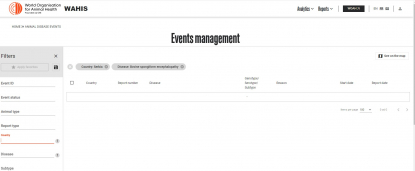“Hey, my friend, I was just wondering why Serbia doesn’t have African swine fever, blue tongue, bird flu or mad cow disease? Because they’re not in the EU!” reads the Facebook post.
Since November 24, 2023, it has been shared more than 2,400 times.

According to comments below the post, certain users seem to believe that these diseases do not exist. “BULGARIANS, DO NOT BELIEVE ANYONE THERE ARE NO SUCH DISEASES NEITHER IN HUMANS NOR IN ANIMALS!!” writes one user. “They don’t exist in Bulgaria either,” comments another. “EU Commissioners spread ‘diseases’ among domestic and wild meat animals through EU agriculture and food ministers,” another comment reads.
However, others point out that the claims are misleading and provide links to recent news reports about outbreaks of infectious diseases among animals in Serbia.
False claims fuel eurosceptic narrative
AFP found that posts with the very same text were already shared in 2019, including this one posted on a Facebook group called “Coalition Exit EU and NATO”.
The post fits into a broader narrative that presents the EU as the leading cause of Bulgaria’s difficulties. AFP has already debunked false claims that the EU has banned domestic livestock, authorised the concealed use of insects in food products and forced Bulgaria to close its coal-powered power plants.
Some of the comments on the Facebook post repeat a falsehood about former EU commissioner and Bulgarian Foreign Minister Mariya Gabriel. AFP has already debunked the claim that Gabriel’s husband had worked for the French laboratory that confirmed the European Union’s first-ever goat plague outbreak. Also known as peste des petits ruminants (PPR), it is a highly contagious viral disease affecting animals such as sheep and goats.
What the data shows
Public data shows that Serbia has encountered three out of four of the diseases mentioned in the false claim on Facebook.
On a global level, information regarding epidemiological situations can be found at the World Animal Health Information System (WAHIS), which is managed by the Paris-based intergovernmental World Organisation for Animal Health (WOAH). According to its website: “When an important epidemiological event pertaining to terrestrial or aquatic animals occurs in a WOAH Member, the Member must inform WOAH by sending an immediate notification” (archived).
“WOAH Members have an obligation to submit information on their animal health situation,” the organisation’s website explains (archived). Serbia, along with more than 180 other countries, is a WOAH member (archived).
AFP consulted WAHIS and applied “Serbia” to filter the results. As we can see from the results below, there are reports on African swine fever, Avian influence and bluetongue disease (archived):

Each event report includes details on the date, location, diseases, animal species, test used, and the laboratory that performed it.
Let’s explain this in more detail.
Ongoing outbreak of African swine fever in Serbia
The WOAH describes African swine fever (ASF) as “a highly contagious viral disease of domestic and wild pigs, whose mortality rate can reach 100%” (archived).
The first cases of ASF in the EU were reported in 2014, and the disease spread among domestic or wild pigs in many countries, including Bulgaria, in 2018.
In August 2023, the Serbian language versions of the BBC and DW reported recent cases of ASF in Serbia (archived links here and here). The first cases date back to 2019 (archived). The Serbian agriculture ministry said in late September 2023 that 4,348 cases of African swine fever had been confirmed in the country and 54,243 pigs had been euthanised (archived).
“Since the first appearance of ASF in Serbia in 2019, the epizootic situation [an outbreak of disease affecting many animals of one kind at the same time] this year is the most unfavourable,” reads this June 2023 article from the Scientific Veterinary Institute in Novi Sad (archived link to the article).

On Serbia’s Veterinary Directorate webpage, there is a “list of decisions on the declaration of an infected and endangered area of the ASF- 2023”. The list includes 77 infected localities (archived link).
According to the latest available follow-up report on the ASF situation in Serbia — from September 8, 2023 at the WOAH website — the outbreak is considered “ongoing” (archived).
The EU’s Animal Disease Information System (ADIS) provides animal disease information “as notified by the countries listed in the document”. Again, Serbia is one of the countries that have reported ASF among domestic pigs (page 1 of the PDF), according to the last summary report as of the end of November 2023 (archived).
“African swine fever (ASF) continued to spread rapidly, affecting primarily small holdings in rural areas and causing considerable economic damage,” reads the latest EC report on EU Enlargement policy regarding Serbia (page 141 of the pdf file).
According to the WAHIS database, as of November 28, 2023, there are 69 reports of ASF with ongoing status all over the world. From the data, one can see that the disease affects not only EU countries (Bulgaria, Germany, Greece, Romania, Latvia, Italy, Hungary, Czech Republic, Poland, Croatia, and Sweden) but also European countries that are outside the bloc like North Macedonia, Bosnia and Herzegovina, Ukraine and all over the world: Hong Kong, Russia, Thailand, South Africa, Mongolia, India and North Korea.

Outbreak of avian influenza in Serbia
Another disease mentioned in the Facebook post is bird flu or Avian influenza (AI), described by WOAH as a “highly contagious viral disease that affects both domestic and wild birds. AI viruses have also been isolated, although less frequently, from mammalian species, including humans.” WOAH also explains that “this complex disease is caused by viruses divided into multiple subtypes (i.e. H5N1, H5N3, H5N8 etc.) whose genetic characteristics rapidly evolve” (archived ).
“Based on the data reported to WOAH, spread [of AI] is lowest in September, begins to rise in October, and peaks in February,” reads this report from the WOAH.
According to the WAHIS database, there are recent reports of AI in Hungary, Sweden, Germany, Norway, Romania, Brazil, the UK, the US, Ecuador and Serbia, where there are cases among wild birds (swans and cranes infected with H5N1, archived link here ). In the past, in Serbia, there have also been reported cases among poultry (H5N1, H5N2, H5N8, etc.)

On November 10, 2023, the Serbian Veterinary Directorate published information on the AI situation with tips on protection (archived).
On November 27, 2023, the public broadcaster RTS reported that a new wave of avian influenza had reached Serbia. It infected cranes, and 500 cranes were found dead. “Bird flu has reached Serbia, what to do if a crane lands in your yard,” the RTS article reads (archived).
In October 2023, media outlets reported that avian flu had reached the Antarctic for the first time.
No cases of mad cow
In the past, according to the WAHIS database, Serbia had also reported outbreaks of another disease mentioned in the post as non-existent in the country: the bluetongue virus.
The disease is defined on the WOAH website as an infectious, non-contagious, vector-borne viral disease that affects wild and domestic ruminants (archived).
According to the WAHIS database, Serbia recorded cases of the disease in 2014, 2016 and 2020 (archived here, here, here).
In October 2023, Science reported that a “potent strain of bluetongue virus is spreading in northern Europe, threatening sheep and cattle” (archived).
The last disease in the post is Bovine spongiform encephalopathy (BSE), widely referred to as “mad cow disease”. According to the WAHIS database, Serbia has never reported cases of that disease, which affects the nervous system of bovines (archived link)
In 2019, the agriculture ministry announced that Serbia had been certified as a country at negligible risk of mad cow disease by the OIE (now WOAH).

According to the WAHIS database, there is only one ongoing BSE event — in the US.
Rossen Bossev
AFP Bulgaria
Translation : Anna Maria JAKUBEK

- Home
- About AFP
- How we work
- Editorial & Ethical standards
- Fact-Checking Stylebook
- Meet the team
- Training
- Subscribe
- Contact
- Corrections
Copyright © AFP 2017-2023. All rights reserved. Users can access and consult this website and use the share features available for personal, private, and non-commercial purposes. Any other use, in particular any reproduction, communication to the public or distribution of the content of this website, in whole or in part, for any other purpose and/or by any other means, without a specific licence agreement signed with AFP, is strictly prohibited. The subject matter depicted or included via links within the Fact Checking content is provided to the extent necessary for correct understanding of the verification of the information concerned. AFP has not obtained any rights from the authors or copyright owners of this third party content and shall incur no liability in this regard. AFP and its logo are registered trademarks.
